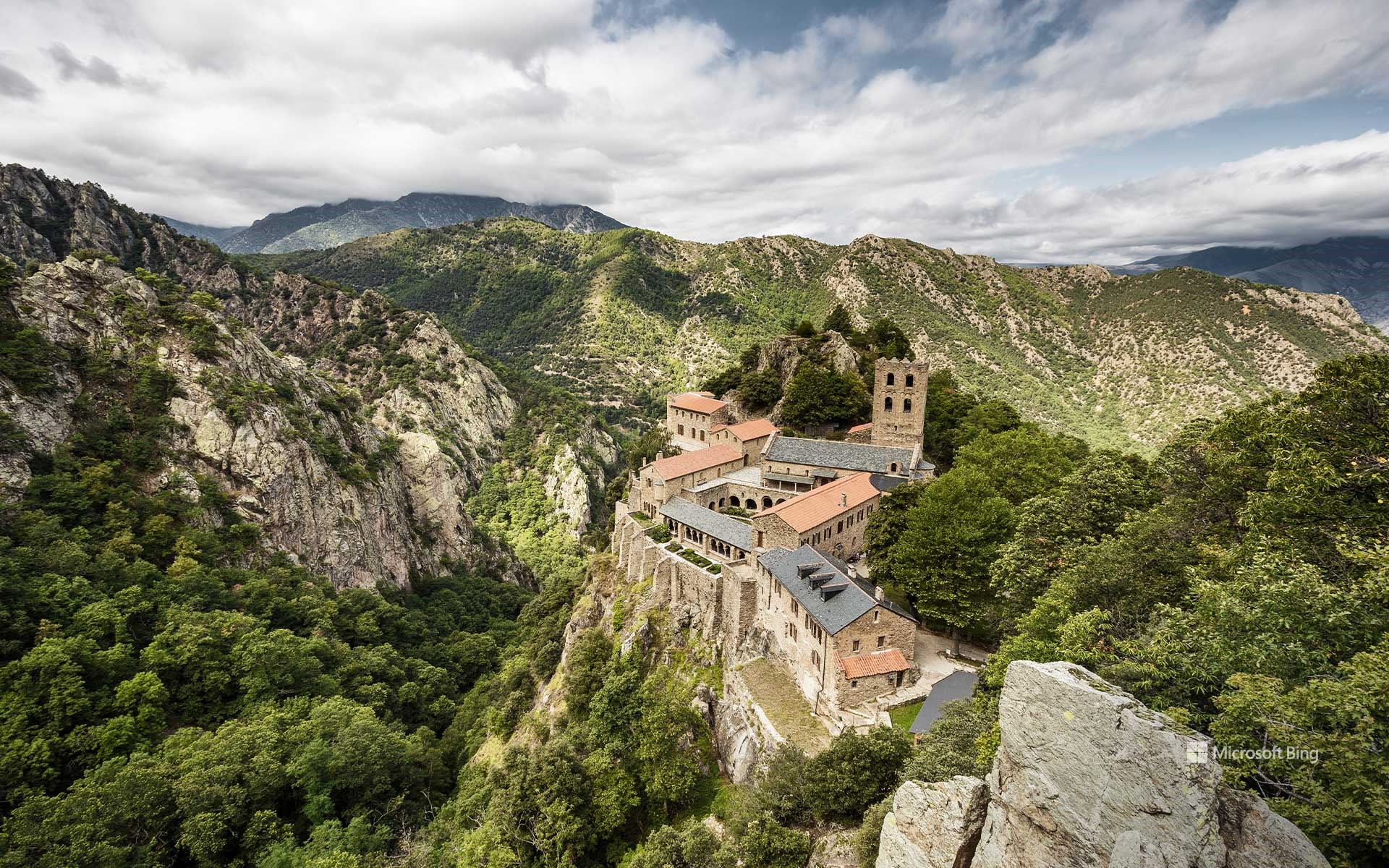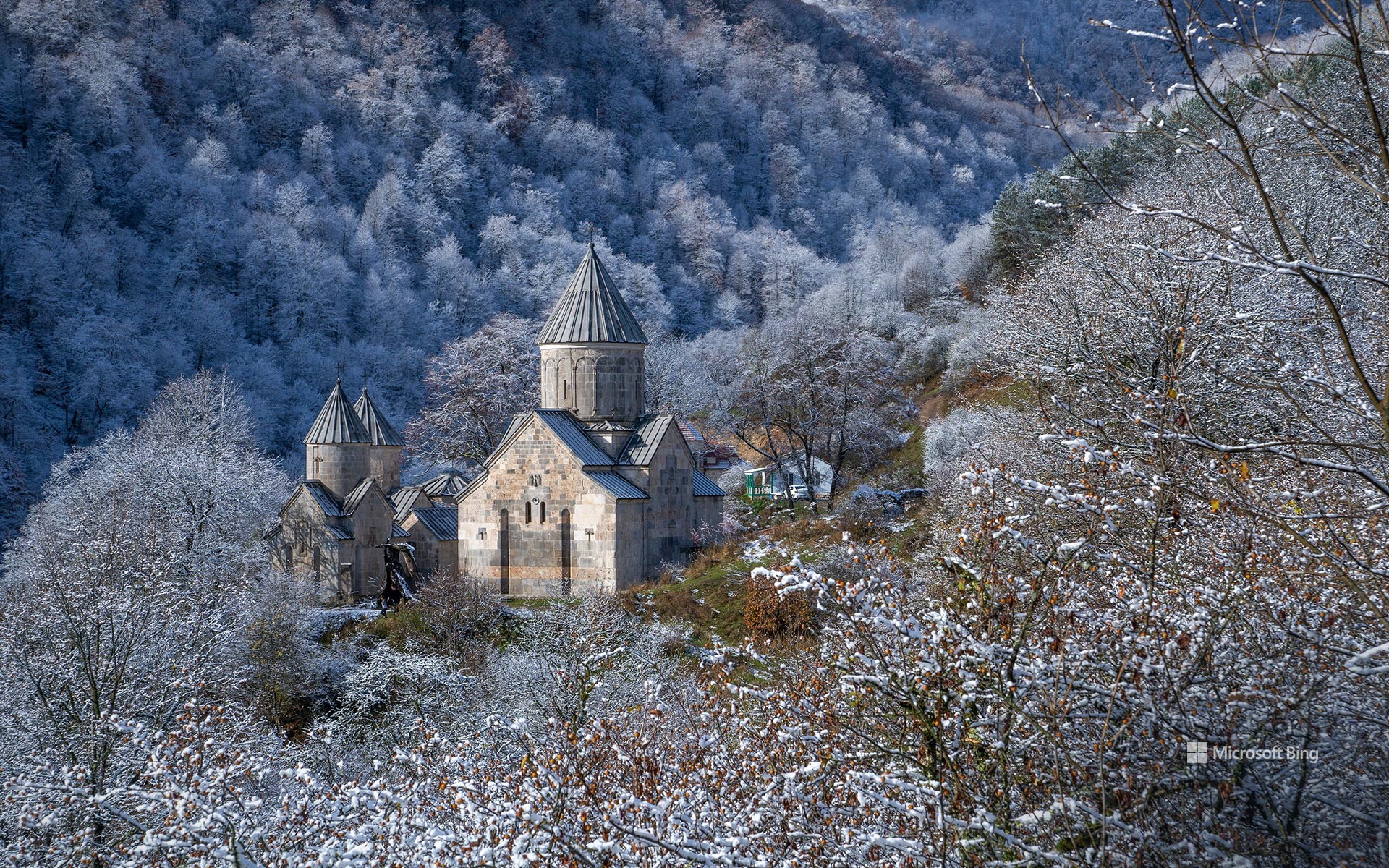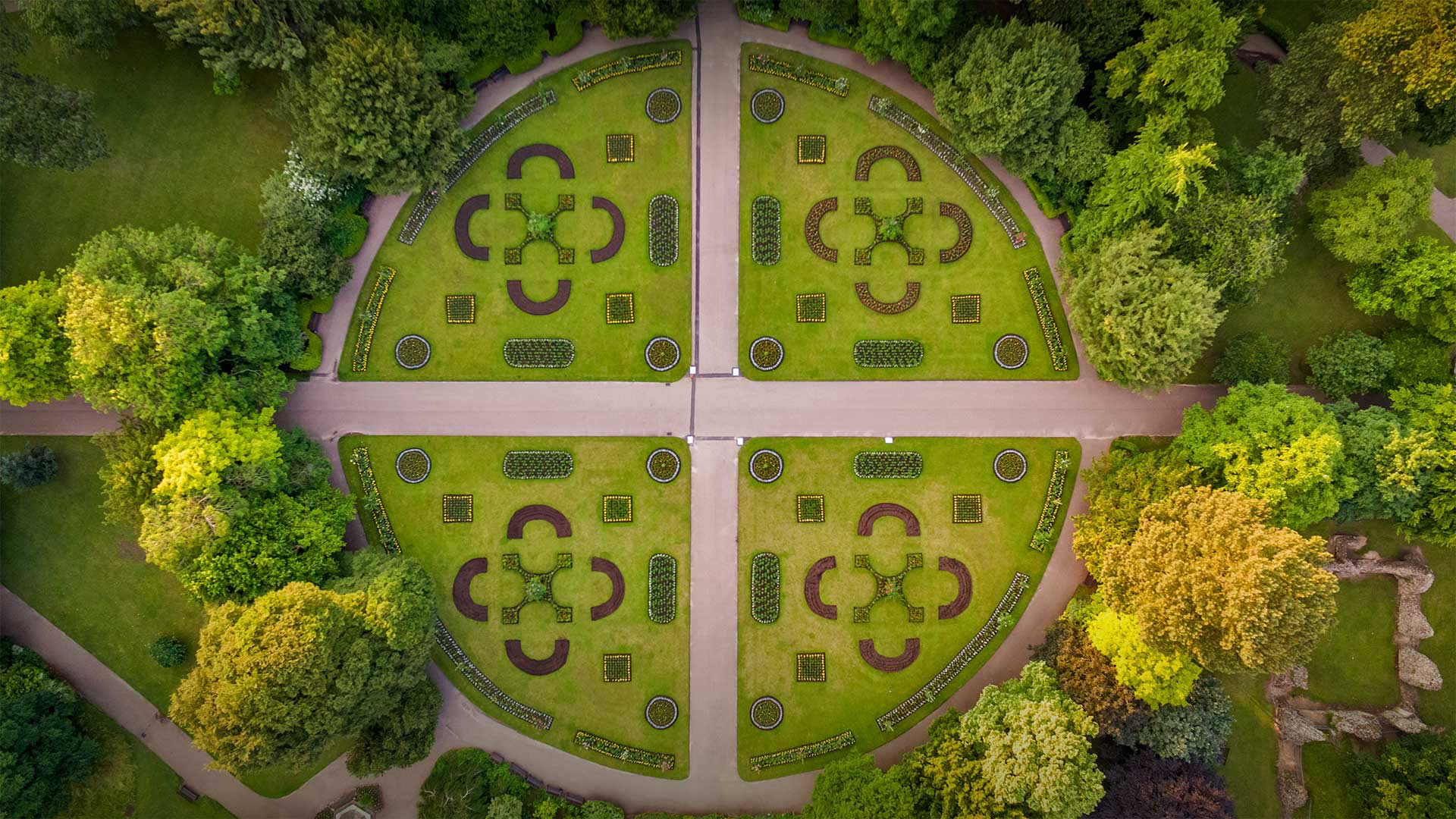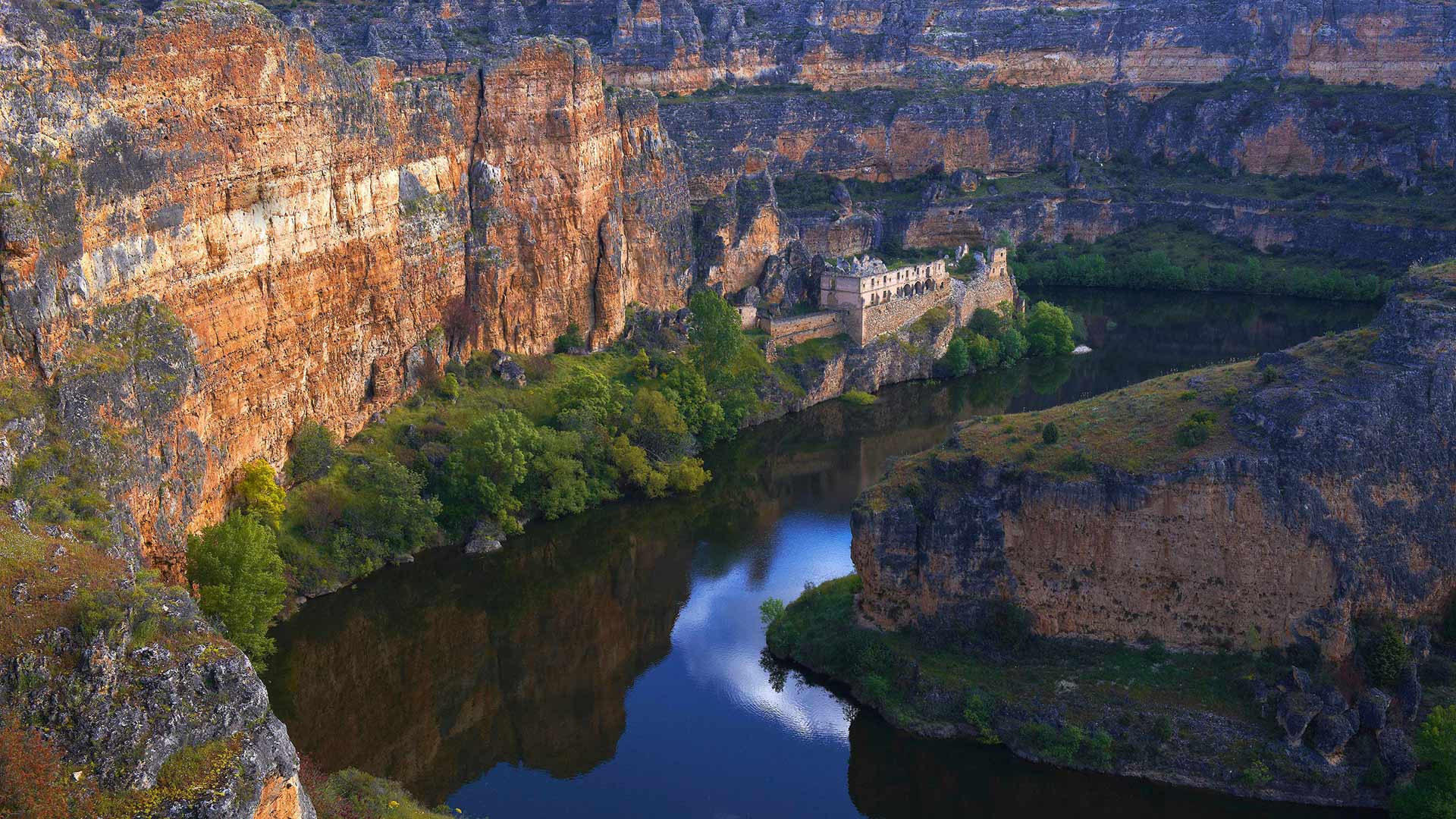标签 修道院 下的文章
代尔修道院,佩特拉,约旦 Ad-Deir, Petra, Jordan (© Punnawit Suwuttananun/Getty Images)

代尔修道院,佩特拉,约旦 Ad-Deir, Petra, Jordan (© Punnawit Suwuttananun/Getty Images)
在失落之城发现美 Finding beauty in the Lost City
代尔修道院,佩特拉,约旦
佩特拉及其皇冠上的明珠——代尔修道院,雕凿在玫瑰色的悬崖峭壁上,让人仿佛置身于电影《印第安纳琼斯》的探险场景中。这座古城坐落在约旦干旱沙漠地貌的中心,曾在公元前2世纪作为纳巴泰王国的首都而繁荣一时。它还是香料贸易的枢纽,连接着中国、埃及、希腊和印度等遥远地区。
今天图片中的代尔修道院可追溯到公元1世纪。其设计融合了希腊风格和美索不达米亚风格。尽管对该建筑的确切用途还存在争议,但普遍认为它在拜占庭时期被用作教堂。这座建筑高近150英尺,宽160英尺,巨大的外墙直接雕刻在砂岩悬崖上,展示了纳巴泰人巧夺天工的工艺和建筑艺术。要到达这座地标性建筑,需徒步攀登800级陡峭的石阶,在岩石地形中蜿蜒前行。尽管攀登的过程有些艰辛,但到达山顶后,你可以俯瞰佩特拉崎岖山谷的全貌,一切努力在此刻都会非常值得。
Ad-Deir, Petra, Jordan
Carved into rose-red cliffs, Petra and its crown jewel, Ad-Deir (The Monastery) feel like stepping into a real-life Indiana Jones adventure. Tucked in the heart of Jordan's arid desert landscapes, this ancient city once thrived as the capital of the Nabataean Kingdom in the 2nd century BCE. It was also a hub of the spice trade, connecting distant regions like China, Egypt, Greece, and India. The city was abandoned for around 500 years before being rediscovered in 1812, earning it the Lost City moniker.
Ad-Deir, seen in today's image, dates to the 1st century CE. Its design is characterized by a combination of Hellenistic and Mesopotamian influences. Although the exact purpose of the structure is debated, it's believed to have been used as a church during the Byzantine period. Standing nearly 150 feet tall and 160 feet wide, its massive facade is carved directly into the sandstone cliffs, showcasing the Nabataeans' ingenious craftsmanship and architecture. The journey to this landmark involves a steep hike up 800 stone steps, winding through rocky terrain. At the top, you're rewarded with panoramic views of the rugged Petra valley that make the climb more than worth it.
圣米歇尔山,诺曼底,法国 Mont-Saint-Michel, Normandy, France (© Captain Skyhigh/Getty Images)

圣米歇尔山,诺曼底,法国 Mont-Saint-Michel, Normandy, France (© Captain Skyhigh/Getty Images)
时间与潮汐之岛 An island of time and tide
圣米歇尔山,诺曼底,法国
欢迎来到法国北部诺曼底的圣米歇尔山,这里是潮汐奇观和中世纪生活的缩影。这个“西方奇迹 ”的故事可以追溯到8世纪初,据说当时大天使米迦勒在异象中出现在阿夫朗什的主教面前。神谕非常明确:在这块岩石上建造一座圣殿。这位主教认真听取了天使的建议,并为目前主宰这座岛屿的修道院奠定了基础。几个世纪以来,这座联合国教科文组织认定的世界遗产的规模和声誉不断扩大,吸引着众多修道士、朝圣者以及入侵者。
圣米歇尔山之所以如此引人注目,其中一个原因就是它的巨大潮差。退潮时,你可以在沙滩上漫步、徒步登岛。但当潮水汹涌而至时,海水就会包围圣米歇尔山,将其变回一座只能通过桥梁才能到达的小岛。这也就不难理解为什么它每年会吸引300多万游客前来造访了。
Mont-Saint-Michel, Normandy, France
A tidal marvel and a slice of medieval life all rolled into one rocky outcrop—welcome to Mont-Saint-Michel in Normandy, northern France. The story of this 'Wonder of the West' goes back to the early 8th century, when St. Michael the archangel was said to have appeared to the bishop of Avranches in a vision. The divine message was clear: build a sanctuary on this rock. Taking this angelic advice seriously, the bishop laid the foundations of what would eventually become the abbey that dominates the island today. Over the centuries, this UNESCO World Heritage Site grew in size and reputation, attracting monks, pilgrims, and invaders alike.
One of the things that makes Mont-Saint-Michel such a striking place is its dramatic tidal range. When the tide is low, you can stroll across the sandy flats and approach the island on foot. But when the tide rushes in, the sea encircles the mount, turning it back into an island that can only be reached over a bridge. It's easy to see why it attracts over 3 million visitors a year.
加泰罗尼亚北部的圣马丁杜卡尼古修道院 ,法国 (© Cyril Gosselin/Getty Images)

加泰罗尼亚北部的圣马丁杜卡尼古修道院 ,法国 (© Cyril Gosselin/Getty Images)
一座千年历史的修道院
圣马丁杜卡尼古修道院 ,法国
想要来一次永恒之旅?圣马丁杜卡尼古修道院向你敞开大门!坐落在东比利牛斯省卡尼古山丘的西麓,这座11世纪的罗马式修道院是一座隐藏的宝藏,正等待着你去探索。修道院坐落在海拔1055米处,位于里多尔塔溪峡谷的边缘,且靠近卡斯特尔村,有着令人叹为观止的景色。从村庄攀登到修道院是一段美好的徒步路程,高差约为250米。
想象一下,你漫步在重叠的回廊中,在拱形的地下室中冥想,或者仰望标志性的钟楼。在这里,真福团体(一个宗教团体)守护着一个充满历史和灵性的活态遗产。来吧,在宁静和令人惊叹的美丽之间,享受一次独特的体验。去圣马丁杜卡尼古修道院,不仅仅是一次参观,更是一次心灵之旅。你准备好开始冒险了吗?
罗萨诺修道院,迈泰奥拉,色萨利 ,希腊 Roussanou Monastery, Meteora, Thessaly, Greece (© Marius Roman/Getty Images)

罗萨诺修道院,迈泰奥拉,色萨利 ,希腊 Roussanou Monastery, Meteora, Thessaly, Greece (© Marius Roman/Getty Images)
屹立于世界之巅 On top of the world
罗萨诺修道院,希腊
一提到希腊,您可能会想到大海、沙滩、白色的建筑和蓝色的圆顶。然而,这个国家的宝藏景点可不止这些。今天的图片展示的是罗萨诺修道院,它坐落于希腊北部色萨利的迈泰奥拉(一个砂岩峰林地区),四周是高耸的悬崖。相传在14世纪,一群僧侣为了躲避政治纷争来到了这里,他们攀爬悬崖,在上面建立起了修道院。如今,在迈泰奥拉联合国教科文组织世界遗产区内还有6座仅存的修道院,而罗萨诺修道院便是其中之一。如果您攀爬上去,将会看到令人惊叹的自然美景,不过,真正的“宝藏”在修道院的内部:一个拜占庭艺术和建筑的世界。这种艺术风格起源于东罗马帝国(也被称为拜占庭帝国),该帝国从公元4世纪持续到1453年君士坦丁堡的陷落,而这一时期的艺术便被人们称为:拜占庭艺术。
The Monastery of Roussanou, Greece
Welcome to the Roussanou Monastery, nestled amidst the towering cliffs of the Meteora rock formation in Thessaly, northern Greece. Roussanou is one of the six monasteries that remain active in this UNESCO World Heritage Site. Despite the construction difficulties, 24 monasteries were founded on these 'columns of the sky' in the 14th and 15th centuries.
Once you've conquered the climb, you'll be greeted by stunning panoramic views, but the real treasures lie within the monastery itself—a world of Byzantine art and architecture. This style emerged in the Eastern Roman Empire, which lasted from the 4th century CE until the fall of Constantinople in 1453. Are you ready to take the climb?
斯凯利格·迈克尔岛上一座古老修道院的废墟,爱尔兰 The ruins of an ancient monastery on the island of Skellig Michael, Ireland (© MNStudio/Getty Images)

斯凯利格·迈克尔岛上一座古老修道院的废墟,爱尔兰 The ruins of an ancient monastery on the island of Skellig Michael, Ireland (© MNStudio/Getty Images)
愿原力与你同在! May the Fourth be with you!
星球大战日
光剑闪闪发光,机器人嘟嘟作响,让我们尽情狂欢吧!在这个银河系的节日里,从观看《星球大战》电影到装扮成自己最喜欢的角色,全世界的星战迷们开始尽情地享受星战的一切。今天的图片展示的是《星球大战》续集三部曲的拍摄地点:爱尔兰西南海岸的斯凯利格·迈克尔岛。这座被联合国教科文组织列为世界遗产的地标建筑中,保存着一座由早期僧侣建立的六世纪修道院。在《星球大战:原力觉醒》中,绝地大师卢克·天行者曾在阿奇托星球上一座与世隔绝的岛屿避难,其取景地正是斯凯利格·迈克尔岛上的蜂巢小屋和石头楼梯。此外,斯凯利格·迈克尔岛上包括海鹦在内的大量海鸟,正是阿奇托岛上那长得像企鹅的波尔格鸟的灵感来源。所以,带上你的伍基人副驾驶,跳上你的星际飞船,在银河系的地球上,开启一段充满力量的旅程吧!
'Star Wars' Day
May the Force be with you on May 4, adopted by 'Star Wars' fans as the day to celebrate their favorite franchise. Many will recognize Skellig Michael, the island on our homepage, as the location of scenes from the 'Star Wars' sequels 'The Force Awakens' and 'The Last Jedi.' This UNESCO World Heritage Site appears in the movies as the planet Ahch-To, where Jedi master Luke Skywalker seeks refuge. Home to a 6th-century monastery with beehive huts and stone staircases, it also hosts a large seabird population that inspired the penguin-like porgs that roost on Ahch-To. Skellig Michael is about 7 miles off Ireland's southwestern coast, daily visitors are limited, and boat trips are canceled if it is too stormy. Still, the island attracts 'Star Wars' fans and others keen to see this ancient site, not so very far, far away.
Haghartsin修道院,迪利扬国家公园,亚美尼亚 Haghartsin Monastery, Dilijan National Park, Armenia (© Alexey Kharitonov/Shutterstock)

Haghartsin修道院,迪利扬国家公园,亚美尼亚 Haghartsin Monastery, Dilijan National Park, Armenia (© Alexey Kharitonov/Shutterstock)
老鹰起舞的地方 Where eagles dance
Haghartsin 修道院,亚美尼亚
Haghartsin 修道院隐藏在亚美尼亚北部的森林之中,被迪利扬国家公园郁郁葱葱的风景所环绕,是亚美尼亚中世纪建筑的瑰宝。修道院的建筑群由几座华丽的建筑组成,包括圣母教堂、圣格雷戈里教堂和圣斯特帕诺斯教堂。这些建筑的历史可以追溯到10世纪,上面装饰着精雕细琢的石碑、十字拱门以及其他装饰物,展现了那个时代的精湛工艺。修道院的名字“Haghartsin”的意思是“鹰之舞”,它为那些想要感受亚美尼亚悠久历史的人提供了一个宁静的去处。当你漫步在幽静的庭院中,探索周围的森林时,一种永恒的感觉油然而生。
Haghartsin Monastery, Armenia
Hidden among the forests of northern Armenia, Haghartsin Monastery is a gem of medieval Armenian architecture. Surrounded by the lush landscapes of Dilijan National Park, the monastery complex consists of several ornate structures, including the Church of the Holy Mother of God, St. Gregory's Church, and St. Stepanos' Church. The buildings date back to the 10th century and are adorned with intricately carved stone monuments, crossing arches, and other decorative details, showcasing the skilled craftsmanship of the era. Haghartsin, which translates to 'dance of the eagles,' offers a serene escape for those seeking to connect with the country's rich history. A sense of timelessness pervades as you wander through its quiet courtyards and explore the forested surroundings.
廷特恩修道院,威尔士 Tintern Abbey, Wales (© matthibcn/Getty Images)

廷特恩修道院,威尔士 Tintern Abbey, Wales (© matthibcn/Getty Images)
一扇通向过去的窗 A cantilevered window to the past
廷特恩修道院,威尔士
位于威尔士蒙茅斯郡的廷特恩修道院有着悠久的历史。这座哥特式建筑杰作始建于1131年,最初是木结构的,后来人们又在1269年用石头重新修建了这座修道院。16世纪,亨利八世与天主教会决裂后,随着修道院的解散,这座建筑也被遗弃。在中世纪的历史上,这座修道院可谓是平平无奇。但在其后的几百年间,它复杂的建筑结构和周围浪漫的田园风光声名远播,如今,这座修道院已成为了英国的标志性建筑物。多年以来,从画家透纳到诗人威廉·华兹华斯,无数艺术家都被这座修道院吸引。
Tintern Abbey, Wales
Set deep in a gorge of the UK's River Wye, Tintern Abbey has an enduring presence. Originally built in wood, this Gothic masterpiece in Monmouthshire, Wales, was rebuilt in stone in 1269. It was in use for centuries until the dissolution of the monasteries in the 1530s, when Henry VIII broke with the Catholic Church. The building fell into ruin but, as the centuries passed, word of its intricate stones and romantic, pastoral setting spread. From painter J. M. W. Turner to poet William Wordsworth, many artists were drawn to the abbey over the years. This majestic ruin is now a national icon on the Welsh bank of the River Wye, on the border between Wales and England. There's another abbey in County Wexford, Ireland, of the same name. Back in olden days, the one in Wales was often known as 'Tintern Major,' while the Ireland one was called 'Tintern de Voto' (Tintern of the Vow).
伯里圣埃德蒙兹镇的修道院公园,英国萨福克郡 Abbey Gardens in Bury St Edmunds, Suffolk, England (© Charles Martinez/Amazing Aerial Agency)

伯里圣埃德蒙兹镇的修道院公园,英国萨福克郡 Abbey Gardens in Bury St Edmunds, Suffolk, England (© Charles Martinez/Amazing Aerial Agency)
绝妙的对称性 Stunning symmetry
Abbey Gardens in Bury St Edmunds, England
Abbey Gardens in Bury St Edmunds comprise a living, vibrant park, and just not because of their 14 acres of colorful displays and ornate flowerbeds—they have changed with the times, all while still jealously guarding their history. The site here in the county of Suffolk, in eastern England, was originally home to a powerful Benedictine Abbey in medieval times—in fact, 2022 marks the 1000th anniversary of the storied abbey. You can still visit the abbey ruins and marvel at the 14th-century Great Gate and Norman Tower, which have survived through the ages. Nathaniel Hodson took the original Abbey Gardens and designed them as a botanic garden in 1831, using the Royal Botanic Gardens in Brussels, with its concentric circles, as his inspiration.
A century later, the people of Bury St Edmunds saw the popular park's circular beds replaced by 64 island beds in honor of George VI's coronation, which they celebrated in 1937, all set off by specially designed illuminations. A water garden and rose garden added more dimensions to the park, followed by an herb garden (the monks of yesteryear would be happy) and a sensory garden for the visually impaired. Today, gardeners plant about 20,000 plants in the spring to dazzle summer visitors, and then they do the same with 12,000 plants and 20,000 bulbs each fall in anticipation of a colorful display the next spring.
英国伯里圣埃德蒙修道院花园
伯里圣埃德蒙的修道院花园是一个充满活力的公园,但这并不是因为它们14英亩的彩色展示和华丽的花坛,它们随着时代的变化而变化,同时仍在嫉妒地守护着它们的历史。该遗址位于英格兰东部萨福克郡,中世纪时曾是一座强大的本笃会修道院的所在地。事实上,2022年是这座历史悠久的修道院的1000周年纪念日。你仍然可以参观修道院遗址,并惊叹于14世纪的大门和诺曼塔,它们历久弥新。1831年,纳撒尼尔·霍德森(Nathaniel Hodson)以布鲁塞尔皇家植物园(Royal botanic Gardens)及其同心圆为灵感,将修道院最初的花园设计为植物园。
一个世纪后,伯里圣埃德蒙兹的人们看到了受欢迎的公园的圆形床被64张岛屿床所取代,以纪念乔治六世的加冕典礼,他们在1937年庆祝了加冕典礼,所有这些都由专门设计的照明装置所衬托。一个水上花园和玫瑰园为公园增加了更多的空间,接着是一个草本花园(去年的僧侣们会很高兴)和一个视觉障碍者的感官花园。如今,园丁们在春季种植了约20000株植物,以吸引夏季游客的眼球,然后他们每年秋天都会种植12000株植物和20000株鳞茎植物,以期待来年春天的多彩展示。
邓弗里斯和加洛韦的甜心修道院,苏格兰 Sweetheart Abbey, Dumfries and Galloway, Scotland (© Westend61/Getty Images)

邓弗里斯和加洛韦的甜心修道院,苏格兰 Sweetheart Abbey, Dumfries and Galloway, Scotland (© Westend61/Getty Images)
一场光明正大的示爱 A very public display of affection
Sweetheart Abbey, Scotland
They say Paris is 'the city of love' but there's a lesser-known place where love is the whole reason it even exists. We're in a Scottish village now known as New Abbey, about 6 miles south of Dumfries. We've stepped inside the ruins of Sweetheart Abbey, the testament to a 13th-century love between a husband and wife. Founded in 1273 by 'lady of substance' Dervorguilla of Galloway, the abbey was constructed solely to commemorate her love for English nobleman John de Balliol upon his death in 1268.
Her devotion didn't end there, though. It's said she had his heart embalmed and placed into an ivory casket bound with silver. She then carried it with her everywhere she traveled for the rest of her life. Dervorguilla and the heart were eventually laid to rest alongside John at the abbey when she passed in 1290. As time progressed, sadly, the lovers' graves were lost to war.
The ruins of Sweetheart Abbey aren't the only remnants of this ancient love still standing today. Dervorguilla, far wealthier than her husband, paid off one of his debts after he died by founding Balliol College of the University of Oxford. She also provided the capital for a permanent endowment for the college, which still exists today—the history students' society is even called the Dervorguilla Society.
苏格兰甜心修道院
他们说巴黎是“爱的城市”,但有一个鲜为人知的地方,爱是它存在的全部原因。我们在苏格兰的一个村庄,现在被称为新修道院,位于Dumfries以南约6英里处。我们走进了情人修道院的废墟,这是13世纪夫妻之间爱情的见证。这座修道院于1273年由加洛韦(Galloway)的“物质夫人”德沃吉拉(Dervorguilla)修建,专门纪念她在1268年英国贵族约翰·德·巴利奥尔(JohnDeBalliol)去世后对他的爱。
然而,她的忠诚并没有就此结束。据说她对他的心脏进行了防腐处理,并将其放入一个镶银的象牙棺材中。然后,她把它带到了她余生旅行的每一个地方。1290年,德沃吉拉和心脏最终与约翰一起在修道院安息。随着时间的推移,不幸的是,这对恋人的坟墓被战争夺去了。
甜心修道院的废墟并不是这段古老爱情的唯一遗迹,它至今仍屹立不倒。Dervorguilla比她的丈夫富裕得多,在他去世后,她通过创建牛津大学巴利奥尔学院偿还了他的一笔债务。她还为该学院提供了永久性捐赠资金,该学院至今仍然存在。历史学生协会甚至被称为Dervorguilla协会。
杜拉通河谷中的Nuestra Señora de la Hoz老修道院,西班牙塞哥维亚 Nuestra Señora de la Hoz, an old monastery in the Duratón River gorge, Segovia, Castile and León, Spain (© Arco Images GmbH/Alamy)

杜拉通河谷中的Nuestra Señora de la Hoz老修道院,西班牙塞哥维亚 Nuestra Señora de la Hoz, an old monastery in the Duratón River gorge, Segovia, Castile and León, Spain (© Arco Images GmbH/Alamy)
A gorge-ous spot for a monastery
Lace up your walking shoes and let’s head into the Hoces del Rio Duratón, in the Spanish region of Castile and León. This imposing 17-mile-long limestone gorge boasts towering vertical walls that can reach up to 100 metres high. The Duratón river which carved it meanders through a landscape rich in history and archaeological treasures.
Inside the cliffs are several caves with ancient paintings dating back to the Bronze Age, and a dark Visigothic grotto which is thought to be the first Christian temple in the region. Above one of the bends in the canyon sits a 12th century Romanesque church, just a few miles away from the ruins of the long-abandoned and isolated Franciscan monastery you see in our homepage image.